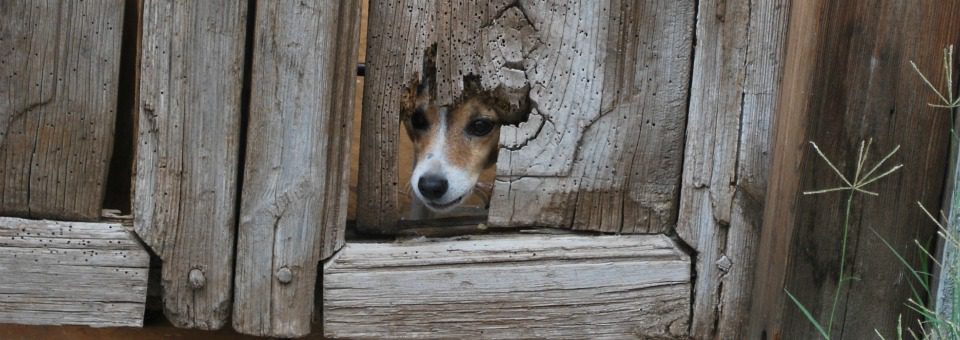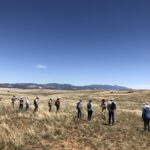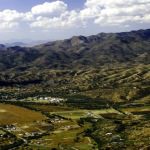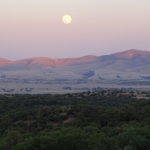Local, State, and National News that affects the Patagonia, Arizona Area
Click on the headline to go to the story. We post relevant Patagonia news regularly!
2015 Patagonia News
Cleanup underway at site of toxic sludge mine spill
The U.S. Forest Service has begun cleaning up an abandoned mine site in the Patagonia mountains. Forest service officials said the objective of the cleanup is to reduce or eliminate the downstream movement of waste rock containing elevated concentrations of arsenic, lead and other heavy metals, as well as acid mine drainage to Harshaw creek. TucsonNewsNow 11/13/2015
Patagonia mine cleanup nearing completion
Eli Curiel, on-scene project coordinator for the Coronado National Forest, said work on the Lead Queen Mine, which leached heavy metals into a drainage above the Harshaw Creek watershed following a major storm event in September 2014, should be completed by Thanksgiving, well before the February 2016 deadline. Weekly Bulletin 11/13/2015
Brazil mining dams burst: ‘Hopes of finding survivors fading’
A huge wall of red sludge descended on the south-eastern village of Bento Rodrigues when two dams holding waste water from an iron ore mine collapsed. Hundreds of rescue workers continue to search for 26 people who are missing feared dead. BBC 11/9/2015
Bennet, New Mexico lawmakers introduce bill to reform 1872 mining law
Colorado U.S. Sen. Michael Bennet joined with his Democratic colleagues from New Mexico on Thursday to unveil a bill to reform the nation’s hardrock mining laws in response to the Gold King Mine spill. Durango Herald 11/5/2015
Plan to Seal Polluted Mine, Stop Runoff, Near Patagonia Ready
The Coronado National Forest and the U.S. Geological Survey have finalized a plan to plug a long-defunct mine that polluted a local waterway more than a year ago. Reports of sludge flowing from the Lead Queen Mine south of Patagonia came in September 2014. Arizona Public Media 11/2/2015
Freeport to cut 430 jobs at Sierrita Mine, consider shutdown
Freeport McMoRan Inc. will eliminate 430 jobs — more than one-third of the workforce — at its Sierrita Mine in Green Valley in January because of plunging prices for the molybdenum and copper mined there. Arizona Daily Star 10/23/2015
Four Sonoita Wineries To Visit: Callaghan, Dos Cabezas, Lightning Ridge & Rune
Only an hour’s drive south of Tucson is the town of Sonoita, home to some of Arizona’s most distinctive and prestigious wines. (Both Callaghan Vineyards and Dos Cabezas WineWorks have had their wines poured at the White House.) Sonoita, at about 5,000 feet elevation, is a cooler, greener respite from the intense desert heat, and you’ll typically meet the winemaker in his or her winery’s tasting room. Tucson Foodie 10/22/2015
EPA mine spill was preventable, points to broader problem
Given industry opposition to efforts to hold mine owners accountable, the cleanup on hard-rock mines such as Gold King has been left to a scattering of federal and state agencies, without common standards or even lists of the most problematic mines. Associated Press 10/22/2015
Arizona approved for cross-state bicycle route
Michael Sanders, ADOT’s bicycle and pedestrian coordinator, said the route will stretch 573 miles across Arizona from the California border to the New Mexico border. The roads were chosen to highlight Arizona’s natural attractions, but also to provide safe rides. Arizona Republic 10/15/2015
CBS 5 Investigates abandoned mines polluting Valley’s water supply
The state of Arizona is home to an estimated 100,000 abandoned mines, but no state or federal agency has an accurate count of how many of them are leaking toxic heavy metals into the environment and waterways. CBS 5 Investigates collected soil and water samples from the areas around six old uranium, lead, silver and copper mines. The tests showed levels of heavy metals that were under the EPA standards for toxicity, but alarming to the scientists who conducted the testing. CBS 5 KPHO 10/7/2015
Hudbay CEO: Rosemont hopes to start construction next year
Rosemont Mine’s owner hopes to start construction of the $1.5 billion project next year and to mine copper there two years later, its CEO says. But while the company says it’s optimistic about its prospects for getting permits and having the money to build the mine, other sources suggest the road to Rosemont remains paved with uncertainties on both fronts. Arizona Daily Star 10/3/2015
Legal Victory for the Patagonia Mountains Important Bird Area
A year ago, we reported that the Sierra Vista Ranger District of the U.S. Forest Service had issued a “categorical exclusion” (CE) to foreign-owned Regal Resources for its proposed “Sunnyside” exploratory mineral drilling project in Humboldt Canyon of the Patagonia Mountains. Vermillion Flycatcher Oct-Dec/2015
Counting Cuckoos in the Coronado
How Yellow-Billed Cuckoos Use Sky Island Habitats in Southeast Arizona Vermillion Flycatcher Oct-Dec/2015
Vincent Pinto Leads the Way for “Seven Saturdays” in Patagonia
Patagonia resident Vincent Pinto of Ravens-Way Wild Journeys has graciously agreed to guide the Paton Center’s 2015-16 Seven Saturdays in Patagonia bird and biodiversity hikes, and Tucson Audubon members are in for a treat! Vincent has blazed a unique career path combining formal academic work in wildlife biology and environmental studies with outside-the-box nature adventures and earth stewardship. He is a visionary, hands-on conservationist, a local bird expert, a passionate interpreter of the Patagonia wilds… and more. Vermillion Flycatcher Oct-Dec/2015
Ruling halts proposed drilling near Patagonia
It was a grey day for the so-called Sunnyside project last week after a federal judge ruled that a Canadian mining company could not proceed with a proposed exploratory drilling project on Coronado National Forest land near Patagonia. Weekly Bulletin 9/23/2015
Judge Blocks Mining in Arizona ‘Sky Island’
Threats to yellow-billed cuckoos, jaguars and Mexican spotted owls warrant a closer look before mineral exploration in the Patagonia Mountains south of Tucson can proceed, a federal judge ruled. Courthouse News 9/18/2015
Court ruling makes things look brighter in the Mountain Empire
This week we got great news for wildlife in the Mountain Empire in southern Arizona. The federal district court in Tucson put the brakes on a damaging exploratory drilling project in the Coronado National Forest near the town of Patagonia. The Mountain Empire region is a special part of the United States, fostering some of the greatest biodiversity in the country! We have been fighting hard to keep the “Sunnyside” project from moving forward. This project would have destructive and lasting impacts on imperiled and threatened species like the jaguar, Mexican spotted owl, ocelot, lesser long-nosed bat and yellow-billed cuckoo, along with local residents in Patagonia. Defenders of Wildlife blog 9/16/2015
Judge rules against mining project near Patagonia
A federal judge ruled Tuesday the U.S. Forest Service erred in allowing a mining project to move forward without a detailed environmental review. The Sunnyside Project was slated to begin on Oct. 1 and included drilling six 6,500-foot holes so mining company Regal Resources USA Inc. could explore the copper content of a national forest area about 5 miles south of Patagonia. Arizona Daily Star 9/16/2015
Forest Service approval of mining project in Arizona reversed by judge
The Forest Service must take another look at a mining project it approved in the Coronado National Forest, following a federal judge’s decision that found the service improperly excluded the project from NEPA review (Defenders of Wildlife v. U.S. Forest Service, 14-2446-TUC-RM, D. Ariz.). Endangered Species & Wetlands Report 9/16/2015
Watchdog: Feds lack abandoned mine count after Colorado mine spill
A report released Friday by Congress’ nonpartisan watchdog agency says federal officials do not have a firm grasp on the thousands of abandoned and potentially dangerous mines on its land. Denver Post 9/11/2015
As Congress Investigates the Cause of the Animas Spill, the Solution Hides in Plain Sight.
Yesterday, the House Science, Space, and Technology Committee held the first of four scheduled Congressional hearings pointing blame at the Environmental Protection Agency (EPA) for the Gold King mine disaster. In fact, for years leading up to the August 5 disaster, Gold King continuously released roughly the same amount of acid mine drainage each week. According to EPA’s own internal investigation, a disaster like this was waiting to happen. EARTHWORKS EARTHblog 9/10/2015
Rodeo weekend fills grandstands, coffers
The usually high lonesome Sonoita crossroads became a wild whirlwind of activity and wholesome fun during the Labor Day weekend. Ground zero was the Santa Cruz County Fairgrounds where beginning on Saturday, the grandstand brimmed with spectators as cowboys and cowgirls blasted out of the chute competing for big prize money and belt buckles. Weekly Bulletin 9/9/2015
Student project results in new jaguar sighting
It is not every day a rare charismatic carnivore steps in front of a wildlife camera, especially when there is only one jaguar currently known to roam southwestern Arizona. But that is exactly what happened to Dean Goehring, a student at Prescott College, in the process of earning his Bachelor of Science in Environmental Studies. Sky Island Alliance News Release 9/8/2015
Congress wades into toxic mine spill caused by EPA crew
The focus on a toxic mine spill that fouled rivers in three Western states shifts to Congress this week as lawmakers kick off a series of hearings into how the U.S. Environmental Protection Agency accidentally unleashed the deluge of poisoned water. KVOA 9/7/2015
Unlikely Heroes
Hawks act as hummingbirds’ bodyguards—whether they realize it or not. onEarth Magazine 9/5/2015
Hudbay sticks to Rosemont despite copper price tumble
The Toronto-based company proposing to build the Rosemont Mine southeast of Tucson says it’s still committed to the project despite continued copper price declines. Arizona Daily Star 9/5/2015
Wildlife groups trying to block Patagonia drilling project
Wildlife protection groups are trying to put the brakes on a mining project in the Patagonia Mountains slated to start Oct. 1. The Defenders of Wildlife and the Patagonia Area Resource Alliance took their case to federal court in Tucson on Thursday, arguing the U.S. Forest Service should have conducted a more detailed examination of potential wildlife impacts before approving a proposal to drill 6,500-feet deep holes.
With the Sunnyside Project, mining company Regal Resources Inc. plans to drill six holes to analyze the copper content of the area about five miles south of Patagonia. At issue is a “categorical exclusion” issued by the Forest Service, which allows the project to move forward without preparing an environmental impact assessment. Arizona Daily Star 9/3/2015
Legacy of Hard Rock Mining in the West – Death of a River, a Community’s Response
A century and a half of hard-rock mining with no accountability, without consideration for environmental consequences or downstream neighbors has taken a heavy toll in the West. Metallic, acidic wastewater from mines have a long-term effect on agriculture, ranching, aquatic life, human and wild life, and aquifers. Huff Post 9/2/2015
New Mining Bill Introduced
Raúl M. Grijalva (D-Ariz.), together with 16 co-sponsors, recently introduced the Hardrock Mining Reform and Reclamation Act of 2015, in an effort to address the nation’s backlog of abandoned mine cleanups and to ensure that taxpayers get a fair share from public lands mining. The number of hardrock abandoned mine lands (AMLs) that will require cleanup is 7,700 – 31,000. Federal estimates of the cost to clean up abandoned mines are as high as $54 billion. In addition, mining companies currently pay no royalties for hardrock minerals they take from publicly owned federal land. Patagonia Regional Times 9/2015
A Boost For Patagonia’s Ecotourism
Patagonia’s economy will soon benefit from an infusion of $100,000, thanks to the Patons, and to Tucson Audubon (TAS), current curator of Paton Center for Hummingbirds. TAS submitted a grant request to Artplace, one of the largest national philanthropies dedicated to creative place making. Patagonia Regional Times 9/2015
The Politics of Mining
A year ago, floods in two abandoned mines in the Patagonia Mountains pushed toxic mine waste into local streams. The PRT’s front page carried a picture of the sludgy orange water running downhill, carrying heavy metals into Harshaw and Sonoita Creeks. Last week The Animas River in Colorado filled with a flood of similar heavy metals. Patagonia Regional Times 9/2015
Front Yard Farming
There are no lawn ornaments in Summer Lewton’s front yard. Most of it has been converted to fertile garden plots from which she grows and sells tomatoes, squash, melon, cucumbers, garlic, onions, eggplant, and peppers. In the back she cares for 40 Rhode Island Red chickens, and there are beehives as well, maintained by Summer’s husband, Sasha. Patagonia Regional Times 9/2015
Buying Local in Sonoita
Harvest season is winding down, but there is still a selection of fresh veggies to be found at the weekly Farmer’s Market in Sonoita Patagonia Regional Times 9/2015
Antiquated mining law hamstrings cleanups
Outdated hard-rock mining laws enacted in the 1870s tie the hands of the federal government to curb pollution that contaminates water supplies, as was the case with the Gold King Mine spill. Perhaps the most significant deficiency comes in the form of a “free and open” provision of the Mining Law of 1872, otherwise known as a “right to mine.” Limited reforms have been made to the law over the last 143 years, leaving in place a provision that prohibits the federal government from blocking a mine from opening or even collecting royalties from operations. Durango Herald 8/31/2015
The Grand Canyon has an alarming amount of mercury and selenium
Amid both the national conversation about water pollution following the Animas River spill and a controversial debate over whether to tighten laws within the Clean Water Act, a recent U.S. Geological Survey study found that human activity is causing an alarmingly high concentration of toxins in one of our most important ecosystems. Phoenix New Times 8/31/2015
Mining companies cut jobs across Arizona
The mining company, ASARCO, might cut more than 200 jobs north of Tucson. KVOA 8/30/2015
Toxic Legacy: 1872 Law Lets Miners Profit on the Backs of American Taxpayers
The Mining Law of 1872 is, quite simply, a miner’s dream. It allows mining companies to buy public land free and clear for as little as $5 an acre if they discover a valuable mineral deposit, and even when the land remains in public hands, companies extract billions of dollars of valuable metals that belong to the American taxpayer without paying a dime in royalties. HuffPost 8/28/2015
Freeport details local cuts
Copper giant Freeport-McMoRan Copper & Gold isn’t planning significant operational changes at its Sierrita Mine 20 miles southwest of Tucson. But the company preliminarily expects to lay off about 150 Sierrita workers by the end of the year due to organizational changes, the company said. Arizona Daily Star 8/28/2015
Asarco plans layoffs after Freeport cuts, copper industry downturn
For the second time in as many days, Arizona copper mining companies signaled hundreds of coming layoffs in response to weak global demand that could hit eastern Arizona especially hard. Arizona Republic 8/28/2015
Gold King Mine water was headed for the Animas, anyway
The nuts and bolts of acid mine drainage. High Country News 8/28/2015
BECY Program results in Year-Round Job Opportunities for Regional Youth
For the past two iterations of the Borderlands Earth Care Youth (BECY) Institute, the program has been constrained to a 6-week intensive program in July and August that condenses the rich, complex process of landscape restoration into field trips and work days that produce meaningful, tangible results. This fall, however, a generous grant from the USDA will take the program to the next level, expanding it into a year-round job-skills development and business-incubator program. Borderlands Restoration Blog 8/27/2015
Freeport-McMoRan, Asarco both cutting jobs
Activist investor Carl Icahn said late Thursday that he has taken an 8.5-percent stake in Freeport-McMoRan, just hours after the Phoenix-based mining company announced cost cuts in response to declining copper prices and soft economic conditions worldwide. Also, Tucson-based Asarco LLC has disclosed in a filing with the state that it plans to lay off 170 employees by late October. Arizona Daily Star 8/27/2015
America’s toxic mining pools: Ticking time bombs?
There are over 500,000 abandoned mines in the U.S. containing noxious brews. CNBC 8/27/2015
Paton Center webcam goes live
Ever get stuck at a computer, all the while wishing you were outdoors watching nature. Now you can do something about it by checking out the new live webcam at the Paton Center for Hummingbirds in Patagonia. Weekly Bulletin 8/26/2015
Local governments, nonprofits urge mining regulation reforms
It’s been only three weeks since 3 million gallons of wastewater the color of Tang gushed out of an abandoned gold mine in Colorado. But that’s been plenty of time for a coalition of local government agencies and nonprofits to draft and submit a petition demanding reform of mine regulations. Arizona Daily Sun 8/26/2015
‘Most important conservation program you’ve never heard of’ set to expire next month
Conservation advocates are worried the looming expiration of a fund for buying park and forest land and funding local recreation projects may get lost in the shuffle when Congress returns after Labor Day. The Land and Water Conservation Fund, which expires Sept. 30, has been the primary source of money to acquire land for the National Park Service, Forest Service, Fish and Wildlife Service and Bureau of Land Management. Arizona Republic 8/25/2015
HudBay Minerals’ Focus On Copper Is Hurting The Company Right Now
HudBay Minerals (NYSE:HBM) has been betting heavily on the price of copper as it acquired two large copper projects in the past 5 years. It has currently finished the construction activities at the very large Constancia copper-molybdenum project and is gearing up to start building the Rosemont copper project in Arizona. In this article I’ll have a closer look at the company’s financial situation to find out how the low copper price is impacting its cash flows and balance sheet. Seeking Alpha 8/24/2015
Goodbye metals, hello marijuana: Mining firms are switching as the lure of commodities fades
Economic turmoil in China, the world’s second-largest economy and top consumer of industrial metals, has hit commodity prices hard. For the smaller players in the mining industry, that’s made business difficult, and the future uncertain. The solution for some? Enter a booming field that’s relatively unaffected by China and has plenty of upside: marijuana. Quartz 8/24/2015
From Mining to Refining: Low Commodity Prices Force Shift at Industry Giants
The world’s largest mining companies have plenty of nickel. Now they are scrounging around for nickels. In a sign of desperation amid plunging commodity prices, mining companies are delving into low-margin businesses—traditionally the domain of the industry’s middlemen—for new sources of revenue. Wall Street Journal 8/20/2015
EPA says it isn’t monitoring an estimated 161,000 abandoned mines
The Environmental Protection Agency (EPA) has said it has no system for monitoring hundreds of thousands of abandoned mines that pock the American landscape, or knowing which one could be the source of the next big toxic spill. Guardian 8/20/2015
The Silver Lining of the Gold King Mine Spill
The Gold King Mine rupture has been a tragedy for the Animas River basin, the kayakers and fishermen who enjoy it, and the towns that depend on it. It’s also a blunt warning to the EPA to do a better job of cleaning up heavy metals left behind in the country’s 500,000 abandoned mines. Bloomberg 8/20/2015
When a River Runs Orange
The recent mining pollution spill in my corner of Colorado — La Plata County — is making national news for all the wrong reasons. Beyond the spill and its impact on everyone downstream, the underlying causes are far more worrisome and dangerous than just a mistake made by the Environmental Protection Agency. New York Times 8/20/2015
Rosemont mine plan is ludicrous
Provisions as stated in the 1872 Mining Law, as amended, don’t apply even remotely to what is intended for development by Hudbay Mining at the proposed Rosemont site in southern Pima County. To even consider opening a new mine in this area is ludicrous, especially since copper is not in short supply in the United States or worldwide. Weekly Bulletin 8/19/2015
Council learns about Spanish influence on water rights
The Patagonia Town Council held a special meeting Aug. 12, to hear a presentation about the history of Arizona’s water rights laws. Michael M. Brescia, associate curator of ethnohistory at the Arizona State Museum and associate professor of history at the University of Arizona, addressed the council and the audience about the history of water usage laws in the state. Weekly Bulletin 8/19/2015
Fall Festival organizers seek more volunteers and sponsors
With less than two months to go, organizers behind Patagonia’s 27th Annual Fall Festival are looking for more help. “All the ducks are in a row except for volunteers, and we’re still looking for some sponsorships,” festival manager Bonnie MacLean said about the event slated for Oct. 9-11. Weekly Bulletin 8/19/2015
Development and tourism board scrapped
The Nogales City Council voted unanimously to disband the Economic Development and Tourism Advisory Board at its meeting Thursday, a little over a year-and-a-half since the body was formed by the council in January 2014. Nogales International 8/18/2015
Game & Fish to monitor fish at Lake Powell, Lees Ferry, for mine spill impacts
The Arizona Game and Fish Department, in cooperation with the Arizona Department of Environmental Quality (ADEQ), will collect a broad spectrum of environmental samples, both biological and physical, from the Arizona portion of Lake Powell as part of continued monitoring for potential impacts of the Colorado Gold King Mine spill. AZGFD News Release 8/18/2015
Conservationists Intervene in Livestock Industry Challenge to Habitat Protections for Jaguar
The Center for Biological Diversity and Defenders of Wildlife today intervened in a lawsuit brought by ranching organizations that are trying to overturn federal protection of habitat for endangered jaguars in New Mexico. The conservation groups are seeking to ensure that the designation of critical habitat for jaguars, on mostly public land in the Peloncillo and San Luis mountains of New Mexico, is maintained. Center for Biological Diversity News Release 8/17/2015
Every county in America, ranked by scenery and climate
The federal government devised a measure of the best and worst places to live in America, from the standpoint of scenery and climate. The “natural amenities index” is intended as “a measure of the physical characteristics of a county area that enhance the location as a place to live.” The index combines “six measures of climate, topography, and water area that reflect environmental qualities most people prefer.” Those qualities, according to the USDA, include mild, sunny winters, temperate summers, low humidity, topographic variation, and access to a body of water. Washington Post 8/17/2015
Distrust rampant a year after Sonora mine spill
On Aug. 6, 2014, 11 million gallons of a copper sulfate solution poured out of a containment pond and polluted the Bacanuchi and Sonora rivers, affecting the livelihoods of more than 22,000 Sonorans about 25 miles from the Arizona border. Arizona Daily Star 8/15/2015
The Colorado mine spill was predictable and preventable
Westerners know the value of clean water. From farmers in California to brewers in Colorado and fishermen in Montana, water is a part of everything we do. But our water is scarce, so we know not to put our limited water resources at risk. Unfortunately, reckless mining companies have been doing just that for more than a century. Al Jazeera 8/15/2015
What the Gold Mine Disaster Tells Us
The General Mining Law of 1872 is among the last surviving statutes of the boisterous era of westward expansion. Signed by Ulysses S. Grant, it establishes the basic rules for mining hard-rock minerals like gold, copper and uranium on public lands. Useful in its day, the law is a destructive relic now. It allows mining companies to buy federal land for a few dollars an acre, demands no royalties and requires minimal environmental protections while the mine is operating and no cleanup afterward. Its principal legacy, if it can be called that, is a battered landscape of abandoned mines and poisoned streams. New York Times 8/13/2015
The Animas River spill and the myth of mine safety
The definition of a mine, said Mark Twain, is a hole in the ground owned by liars. And this month the industry’s biggest lie — that it can be trusted with our water — is once again on display as another mining disaster has spilled millions of gallons of toxic mining waste and chemicals into our streams, rivers and lakes. Los Angeles Times 8/13/2015
Scientists Say We Could Be Heading Into ‘Godzilla El Niño’
This year’s El Niño is shaping up to be a whopper — potentially surpassing the one in 1997, which was the strongest on record, the National Weather Service says. NPR 8/13/2015
Hunt is on for source of mercury at Peña Blanca Lake
Hired last year by the U.S. Forest Service, the U.S. Geological Survey employee [Floyd Gray] and Anne Billingsley, a Ph.D candidate at the University of Arizona’s geoscience department, were on the hunt for mercury. Specifically, they were looking for signs of the heavy metal pushing its way up from ancient volcanic rock layers below the lake into thin veins running through surface-level rocks. Weekly Bulletin 8/13/2015
National challenge of leaking mines dwarfs Colorado spill
It will take many years and many millions of dollars simply to manage and not even remove the toxic wastewater from an abandoned mine that unleashed a 100-mile-long torrent of heavy metals into Western rivers and has likely reached Lake Powell, experts said Thursday. Arizona Daily Star 8/13/2015
Damages in Colorado mine spill will take years to tabulate
The spill of toxic wastewater from an abandoned gold mine high in Colorado’s San Juan Mountains caused untold millions in economic disruptions and damages in three states – to rafting companies, Native American farmers unable to irrigate, municipal water systems and possibly water well owners. And largely because the federal government inadvertently triggered the release, it has vowed to pay the bill. That bill could be years in the making. Associated Press 8/13/2015
Why Tens of Thousands of Toxic Mines Litter the U.S. West
The fouled waters of the Animas River are slowly clearing, but the widespread hazards posed by toxic mine waste will be with us for centuries. Smithsonian Magazine 8/13/2015
The real culprit in the Animas River spill
What the headlines and photos of bright orange rivers fail to convey is that this mine and thousands of others like it across the country perpetually leak this type of mine pollution into our waters. If there is anything I have learned from the past 15 years of working on this issue, it’s that absent strong regulations and better-designed mines, mining companies will continue to pollute with impunity. CNN 8/12/2015
Animas River spill: Gold King Mine one of many in area releasing heavy metals-laced waste
While state and federal leaders focused on the Gold King Mine blowout and downriver contamination, three adjacent mines still are leaking more than 540 gallons per minute of waste laced with heavy metals into Animas River headwaters. Denver Post 8/12/2015
Town to hold special meeting on ‘unique water rights’
As Patagonia searches for ways to secure the depth and health of its wells, an understanding of historical water rights in the area might just lead to some important future decisions. So how did it all begin and why are these rights so unique? Find out for yourself by attending a presentation on the history of the area’s water rights scheduled for 6 p.m. Wednesday, Aug. 12 at the Town Hall. Weekly Bulletin 8/12/2015
Navajo Nation says it feels brunt of Colorado mine leak
Russell Begaye stared into a hole in the side of a Colorado mountain, watching as yellow water contaminated with heavy metals poured out and raced down a slope toward a creek that feeds rivers critical to survival on the nation’s largest Native American reservation and in other parts of the Southwest. Associated Press 8/12/2015
Audubon New Mexico Releases Statement on Animas River Contamination
“Riparian-dependent plants and animals cannot avoid the oncoming disaster,” said Sharon Wirth, Audubon’s Freshwater Program Manager who has 15 years’ experience in ecological risk assessment of water and sediment contamination. Audubon New Mexico News Release 8/12/2015
Wastewater Heading Toward Arizona
The U.S. Environmental Protection Agency took full responsibility Tuesday for the mine waste spoiling rivers downstream from Silverton, Colorado, but people who live near the idled and leaking Gold King mine say local authorities and mining companies spent decades spurning federal cleanup help. Associated Press 8/11/2015
Colorado now faults EPA for mine spill after decades of pushing away federal Superfund help
The U.S. Environmental Protection Agency took full responsibility Tuesday for the mine waste spoiling rivers downstream from Silverton, Colorado, but people who live near the idled and leaking Gold King mine say local authorities and mining companies spent decades spurning federal cleanup help. They feared the stigma of a Superfund label, which delivers federal money up-front for extensive cleanups. They worried that corporations would kill a hoped-for revival in the area’s mining industry rather than get stuck with cleanup costs. And some haven’t trusted the federal government, townspeople say. Associated Press 8/11/2015
Major Colorado mine waste spill highlights urgency for comprehensive mining law reform
Last Wednesday, the US experienced one of its worst mining-related disasters in decades, and it’s received a lot of attention both here in Colorado and nationally. There’s been no shortage of name calling and blaming, but few seem to be speaking of the bigger picture: how can we learn from this and write policies and regulations that stop this from happening again? EARTHWORKS EARTHblog 8/11/2015
CAP Official: Mine Contaminants Likely Won’t Affect Arizona Water Supply
Water contamination from an abandoned Gold King Mine in Colorado in is flowing toward Lake Powell and the Colorado River. While the Phoenix area uses Colorado River water, officials believe there is little to worry about. KJZZ 8/11/2015
Gold mine spill shines light on practice of avoiding environmental assessment
Pollution on a remote northern B.C. island only discovered after whistleblower reported improper practices. Business Vancouver 8/11/2015
People Flock to Tucson Bird And Wildlife Festival
Birding is a multibillion dollar industry in the United States and southern Arizona is getting a piece of that pie this summer. The Tucson Audubon Society is holding its annual Tucson Bird and Wildlife Festival this month which hopes to attract more than a thousand adults and children. Arizona Public Media 8/10/2015
EPA: Pollution from mine spill much worse than feared
Officials from the Environmental Protection Agency said Sunday that the Gold King Mine discharged an estimated 3 million gallons of contaminated water, three times the amount previously believed. Arizona Republic 8/10/2015
When our river turned orange
Nine things you need to know about the Animas River mine waste spill. High Country News 8/9/2015
Catastrophe on the Animas
Acidic wastewater from an abandoned mine above Silverton coursed its way through La Plata County on Thursday, turning the Animas River orange-brown, forcing the city of Durango to stop pumping raw water from the river and persuading the sheriff to close the river to public use. Durango Herald 8/6/2015
New study indicates mine waste disasters increasing worldwide
A new study reveals that catastrophic mine waste failures are increasing in frequency, severity, and costs all around the world. The authors point toward poor regulations, poor practices, dicey mining economics, and ever larger mines as key factors behind those disasters. Georgia Straight 8/6/2015
Mine purchase and cleanup doesn’t please enviro group
A Arizona-based environmental group is not impressed with AZ Mining’s purchase of the 300-acre historic Trench Camp Mine despite a promise to build a water treatment system. Mining.com 8/5/2015
Elgin hops operation taking off
Already on the map for wine connoisseurs, the Elgin area is on the verge of offering something for beer aficionados as well. Since April, Elgin residents Tom and Melanie Pyle have been growing nine varieties of hops on their property, located at 2330 State Route 83, where a sign reads, “Killer Hops Farms and Heirloom Roadside Garden.” Weekly Bulletin 8/5/2015
AZ Mining Inc. [FKA Wildcat Silver] purchases historic mine, sparks environmental concern
Environmental advocates are questioning the reasoning behind a recent announcement by AZ mining Inc. to purchase the 300-acre historic Trench Camp mine from the Asarco Multi-State Environmental Custodial trust. Tucson News Now 7/30/2015
TAILINGS: Dam breaches increasing in frequency
A new report available at Earthworks Action notes that catastrophic tailings spills are occurring with increasing frequency around the world. Moreover, the new study, The Risk, Public Liability, and Economics of Tailings Storage Facility Failures, points out the failures of regulators and engineers to create truly best practices to minimize financial and environmental risks. Canadian Mining Journal 7/29/2015
Canadian mining firm to add claims in Patagonia Mountains
AZ Mining, a Canadian company conducting exploratory work in the Patagonia Mountains, said it is looking to add 300 acres of patented mining claims to its adjacent Hermosa mining project. According to AZ Mining, formerly known as Wildcat Silver Corporation, the claims are being obtained from the Asarco Multi-State Environmental Custodial Trust and the deal is expected to be completed in 90 days. That includes the abandoned Trench Mine, which in September 2014 leached heavy metals into nearby drainages following heavy monsoon rains. In October, owner Asarco Multi-State Trust was noticed with six violations by the Arizona Department of Environmental Quality (ADEQ) as a result of the leaching. Weekly Bulletin 7/29/2015
Paton Center is Getting a Makeover
I had the chance to go back down to Tucson Audubon’s Paton Center for Hummingbirds two weeks ago with Keith Ashley. The day started meeting with Wendy Russell and Luke Reese, who have close ties with the Patagonia Area Resource Alliance and the Nature Conservancy. We discussed the Sonoita Creek watershed, where the Paton Center is nestled, and various issues surrounding it. Tucson Audubon Blog 7/28/2015
Sky Island Alliance – Protecting and restoring the Sky Islands
Sky Island Alliance – we protect and restore the biodiversity and natural heritage of the Sky Islands. We use science, education, and advocacy to connect the binational landscapes, people, and wildlife of the Sky Islands for the benefit of all. KGUN9 7/28/2015
Legislative attacks threaten Endangered Species Act
The Endangered Species Act is under increased attack by lawmakers, conservationists say, with a slew of legislation proposed this year — including dozens of budget riders tacked onto unrelated bills — aimed at restricting wildlife protection. The act protects more than 1,500 plant and animal species in the U.S. and over 650 foreign species, saving many from the brink of extinction, but activists says the act itself is now under threat from conservative politicians backed by the oil and gas lobby. Al Jazeera America 7/27/2015
IN MY VIEW: Owner doesn’t matter, mine a bad idea
According to a recent editorial, Hudbay Minerals, the new Canadian owners of the mine site on the northeastern face of the Santa Rita Mountains, apparently talks a better game than its predecessor, Augusta Resource (“A look at Hudbay a year into it,” July 19). However, one thing remains constant – regardless of who owns the proposed Rosemont Mine, it is still a bad project for Southern Arizona. It threatens our water, our air quality and our economy. Green Valley News 7/25/2015
AZ Mining to expand Hermosa land package
AZ Mining [FKA Wildcat Silver] is pleased to announce that it has reached agreement to acquire approximately 300 acres of patented mining claims from the Asarco Multi-State Environmental Custodial Trust [Trench Camp Mine.] Consideration for the acquisition will be the assumption of the environmental liabilities relating to the site that resulted from historic mining activity. The Company has submitted a remediation work plan that addresses the environmental liabilities with the Arizona Department of Environmental Quality and will construct a passive water treatment system estimated to cost US$2.6 million, excluding contingency, of which the Company’s share will be US$1.6 million. PR Newswire 7/24/2015
Citing Religious Freedom, Native Americans Fight To Take Back Sacred Land From Mining Companies
For generations, members of the Apache Native American tribe have viewed Oak Flat as a holy, sacred place. Located about an hour due east of Phoenix, Arizona, the land has long served as a site for traditional acorn gatherings, burial services, and rite of passage ceremonies for young women. The flat is tucked inside Arizona’s Tonto National Forest, and has historically been protected by the federal government. But last year, the land quietly became something else: A proposed site for a massive copper mining project spearheaded by Resolution Copper, an organization run by two multinational corporations based in the United Kingdom and Australia. Think Progress 7/24/2015
New Critical Minerals Bill up for Senate Consideration
This week, Senate Energy and Natural Resources Committee introduced a broad package of energy legislation including the Chairman’s bill, S. 883, the American Mineral Security Act of 2015. While serving a number of important purposes, the bill also creates a worrisome permitting structure that could undermine community rights. Earthworks Earthblog 7/23/2015
Apaches take Arizona copper mine protest to White House, Capitol
After weeks of taking their message to churches and tribes around the country, a caravan of San Carlos Apache members sang and prayed in Washington Tuesday for the preservation of sacred sites in southeast Arizona. Arizona Republic 7/22/2015
Rosemont concerns
I appreciate Editor Dan Shearer’s interest in following up on what’s happening with the Rosemont mine project since Hudbay acquired the property (“A look at Hudbay a year into it,” Page A6, July 19). Characteristically, Mr. Shearer went onsite and also researched the company to provide a balanced view. I often agree with his editorials, but I couldn’t disagree more with this one. Green Valley News 7/21/2015
Letters pour into Army Corps on Benson project
Is a planned 28,000-home Benson development progressive and groundbreaking, or a future environmental nightmare? Does it offer relief to a stressed community and county where businesses are closing and jobs being lost regularly? Or does it spell doom for a fragile ecosystem, a globally recognized river and hundreds of bird species that depend on it? These opinions and many more just as passionate — and many others loaded with technical and economic detail — have found their way to the Army Corps of Engineers in nearly 60 letters and emails in the past two months. The Corps is considering whether to revisit a federal permit it granted back in 2006 to what’s now known as Villages of Vigneto. Arizona Daily Star 7/21/2015
Canada’s Mines Ministers ‘Open’ to Taking Action to Prevent Future Mine Waste Disasters, But Concrete Commitments Lacking
As Canada’s annual Energy & Mines Ministers Conference winds up in Halifax, MiningWatch Canada is pleased that Canada’s Mines Ministers have discussed mine waste management issues following last year’s massive Mount Polley spill in British Columbia. But the mining watch dog is also concerned that the meeting will not result with any concrete commitments in in order to prevent future mine waste disasters. MiningWatch Canada News Release 7/21/2015
Corps is reviewing Benson project’s permit
The U.S. Army Corps of Engineers is reviewing a 2006 permit it gave the predecessor of the big Villages at Vigneto development in Benson, a corps official has told the Tucson Audubon Society. Arizona Daily Star 7/17/2015
Vineyard nest boxes receive unexpected guests
An experiment to entice a native subspecies of the eastern bluebird into nest boxes at vineyards in the Sonoita-Elgin area turned up some unexpected guests. Weekly Bulletin 7/15/2015
Wilderness marred by rough-cut mining exploration roads in B.C.
“We strongly oppose the current ‘free rein’ access to the backcountry in pursuit of mineral extraction without regard for the future aesthetic of the land or health of wildlife populations,” the guides stated. “The creation of more roads into undisturbed wilderness is alarming in this day and age when we have other means of exploring without unrepairable damage to the ecosystems. Reclamation efforts are not proven to be a solution to this destruction.” Globe and Mail 7/12/2015
Old mines still plague Montana’s Clark Fork
Why one of the nation’s largest Superfund river sites can’t address pollution from abandoned mines. High Country News 7/10/2015
Tumbling copper prices expected to delay Hudbay’s Rosemont construction plans
Economic turmoil in China has pushed copper prices to a six-year low which is dragging down the share prices of major copper producers including Toronto-based Hudbay Minerals, which is seeking state and federal permits to construct the Rosemont Copper Mine southeast of Tucson. The precipitous decline in copper prices is expected to delay Hudbay’s decision on whether to construct the Rosemont copper project until copper prices recover, which may be several years. Rosemont Mine Truth 7/9/2015
I-Team Part Two: Mines create giant pit lakes
One byproduct of Nevada’s billion dollar a year gold mining industry are so-called pit lakes which will be left behind long after the mining companies have packed up and left. LasVegasNow.com 7/9/2015
I-Team Part One: Mines using large amounts of water
A withering drought is baking much of the west, which means states like Nevada are looking for ways to carefully manage water supplies. In northern Nevada, gargantuan gold mining operations pump enormous quantities of fresh water every day. That has caused some critics to ask whether mining for gold is the best use of a public resource that grows more precious each day. LasVegasNow.com 7/8/2015
Ecological Restoration Is A $25 Billion Industry That Generates 220,000 Jobs
Critics like to portray environmental regulation as a job killer, but the restoration economy now provides more jobs than mining, logging, or steel production – all while actually fixing the environment instead of destroying it – according to a new study. Ecosystem Marketplace 7/8/2015
Corps: We can’t limit pumping near San Pedro
The Army Corps of Engineers says it can’t stop a big development’s proposed groundwater pumping in Benson, despite other federal agencies’ concerns it might dry up the San Pedro River. Arizona Daily Star 7/8/2015
National monuments have a monumental impact on the U.S. economy
National monuments not only protect America’s important wild and historic places, they protect its economy, too. Businesses from outfitters to river guides to local coffee shops all stand to benefit from the increased tourism created by monument designations. Generally, national parks and monuments are known to help local economies diversify, and counties with protected public lands like national monuments have been more successful at holding property values and attracting high-wage employers. Wilderness Society Blog 7/8/2015
Poll Shows 90 Percent Support Endangered Species Act
The Endangered Species Act turns out to be popular among voters and in a positive way. Ninety percent of those polled say they support ESA, according to a survey conducted by Tulchin Research for Defenders of Wildlife and Earthjustice. Public News Service 7/7/2015
Grijalva-led committee reintroduces bills that preserve, restore Arizona public land citing economic, cultural benefits
The House of Representatives’ Natural Resources Committee, led by Arizona Rep. Raúl Grijalva, has reintroduced bills that will restore and preserve Arizona public land citing economic and cultural benefits. Phoenix Business Journal 7/7/2015
California’s rural poor hit hardest as massive drought makes remaining water toxic
In ordinary times, the concentration of naturally occurring arsenic is low, and the water safe to drink. But during California’s unrelenting drought, as municipalities join farmers in sucking larger quantities of water from the ground, the concentration of arsenic is becoming more potent. Washington Post 7/5/2015
Arizona, 12 other states sue EPA over water rules
Last week, Arizona joined 12 other states in filing a lawsuit — one of three filed by a total of more than 20 states — against the rules. Arizona Daily Star 7/4/2015
Cats in the Sonora
We all know that our region is home to some big cats, like mountain lions and bobcats – but JAGUARS? Listen to Sergio Avila of the Desert Museum talk about big cats on the Weekly Green. KXCI 7/4/2015
What If: Paul Gosar, Defenders of Wildlife debate the impact of the Mexican grey wolf in Arizona.
What would happen if there were no Mexican grey wolves in Arizona? We asked two experts to weigh in on federal programs to reintroduce the species. Arizona Republic 7/4/2015
Arizona copper mine stirs debate pitting profits vs religion
Opponents also point to the foreign owners of Resolution Copper Mining, a subsidiary of British-Australian Rio Tinto and Australian BHP Billiton, saying it’s unclear how much of the profits and the copper will stay in the U.S. They also point out the political influence of the corporation — McCain received $10,000 from Rio Tinto this election cycle. Albuquerque Journal 7/2/2015
National Forest suggests road changes in Nogales District
With about 138 miles of unauthorized dirt roads and trails within its jurisdiction of the Coronado National Forest, the Nogales Ranger District is seeking a better transportation management plan. Nogales International 6/30/2015
Paton on the Fly
I had the opportunity to visit the Paton Center for Hummingbirds in Patagonia this past week and it’s definitely one of my new favorite places. The property is quaint, charming, and teeming with life. Tucson Audubon Blog 6/29/2015
Supreme Court won’t hear Renzi’s conviction appeal
Former Arizona Congressman Rick Renzi is going to remain in federal prison. Without comment, the U.S. Supreme Court on Monday upheld his conviction on charges of extortion, fraud, conspiracy and racketeering. He began serving his three-year prison term in February. Arizona Daily Star 6/29/2015
Grijalva Reintroduces Package of Bills that Preserve, Protect and Restore Arizona Public Land, Citing Economic and Cultural Benefits
Ranking Member Raúl M. Grijalva introduced a package of three Arizona public land bills yesterday – the Sonoran Desert Heritage Act, the Southern Arizona Public Lands Protection Act and the Santa Cruz Valley National Heritage Area Act – that mark the latest step in his ongoing efforts to preserve natural and cultural resources throughout the state. Grijalva will be in Arizona next week and available for media inquiries. Natural Resources Committee News Release 6/26/2015
Pronghorn antelope numbers on rise near Sonoita, Patagonia
After four years of comprehensive, science-based management efforts, biologists at the Arizona Game and Fish Department are encouraged by the birth of 84 pronghorn antelope fawns this year and increased pronghorn distribution throughout Game Management Units 34A, 34B and 35A in southeastern Arizona. Arizona Game and Fish News Release 6/24/2015
Land development seriously impacting San Pedro
A regional assessment of the Madrean Archipelago, released last week by the U.S. Bureau of Land Management, cites development and water use as key stressors that can alter the local ecology. Sierra Vista Herald 6/22/2015
Arizona tourism enjoying nice rebound, report says
Arizona tourism reached record levels last year amid an improving economy, creative marketing — and staying off “The Daily Show with Jon Stewart.” New figures Monday show 40.7 million people visited the state and stayed at least one night. That’s a 4.1 percent increase over 2013. And international tourism is up 6.3 percent, hitting 5.7 million people. Most of the travelers came from Mexico, though nearly 900,000 Canadians decided to visit the Grand Canyon State, too. All of that means money — lots of it. Arizona Daily Star 6/22/2015
Opponents renew fight against Superior copper mine
Opponents of a planned copper mine near Superior, slated to become one of the largest in North America, are renewing efforts to kill the project. U.S. Rep. Raúl Grijalva, with the support of fellow Arizona Democrat Rep. Ruben Gallego, introduced a bill Wednesday to block the federal land exchange sought by mining company Resolution Copper to open the mine. Arizona Republic 6/17/2015
Steller: Benson project reveals state’s weakness on water
“Without a doubt,” he [Gov Ducey] went on to say, “Arizona is a national leader — if not the nation’s leader — in proactive water conservation and management.” True enough, and yet a 45-minute drive southeast of Tucson shows how tenuous that title is — and how tempting short-term thinking about water remains. A 28,000-home development in Benson could add up to 70,000 more people to the town’s current population of around 5,000, all of them dependent on the pumping of groundwater. Arizona Daily Star 6/13/2015
‘Get Outdoors Day’ coming to Parker Canyon Lake
Parker Canyon Lake is once again the setting for a “National Get Outdoors Day” celebration. It’s set to run 9 a.m. to 2 p.m. on Saturday, June 13. Weekly Bulletin 6/10/2015
SC County joins interstate system for bikes
A national bike route is set to cut through the northeast corner of Santa Cruz County, connecting the local area with a route that stretches from Jacksonville, Fla. to San Diego. Weekly Bulletin 6/10/2015
“Miracle May” in Colorado boosts Lake Powell June runoff
An unexpected, late series of storms in Colorado gave a big boost to the spring-summer runoff leading into Lake Powell at the Utah border. While the extra burst of runoff in May and early June reduces the chance of shortages for the Central Arizona Project in 2016, it’s not enough to help the $4 billion water project avoid shortages the following year, a top CAP official said Monday. Arizona Daily Star 6/8/2015
Unions to end contract with Tucson-based Asarco
Unions representing about 2,000 hourly workers of Tucson-based copper producer Asarco LLC have put the company on 15-day notice that they intend to terminate their labor contract. “After two years of negotiations, including meetings this week, too many of Asarco/Grupo Mexico management’s unfair, discriminatory and one-sided proposals remain on too many issues to continue with the status quo,” the message to union members said. Arizona Daily Star 6/5/2015
Oak Flat Protesters Plan March on Washington to Protest Apache Land Grab
Now Native American protesters from around the country will gather there en masse in the third week of June to seek repeal of a law that a recent New York Times Op-Ed piece termed “a new low in congressional corruption.” Indian Country Today 6/4/2015
Wildcat Silver Changes Name to AZ Mining Inc.
Wildcat Silver Corporation (TSX: AZ) announces it has changed its name to AZ Mining Inc. The name change to AZ Mining Inc. reflects both the Company’s focus on its Hermosa property located near Patagonia in southern Arizona and the poly-metallic nature of the mineralization on the two current projects. The Company’s shares will commence trading under the symbol AZ on the Toronto Stock Exchange on Friday June 5, 2015. CNW 6/4/2015
Town explores its water rights
Water is once again on the mind of the Town of Patagonia, especially in regard to defending it. As a result, during the town council’s May 27 regular meeting, lawyer Steve Weatherspoon was invited to discuss the current status of Patagonia’s water rights. Weekly Bulletin 6/3/2015
Arizona-Mexico Border Patrol Bill And Mine Provoke Protests Against John McCain In Tucson
A small group of protesters took to the streets outside of Sen. John McCain’s Tucson, Arizona, office on Wednesday, banging drums and decrying two of the senator’s recent actions in Washington that affect the borderlands and Native American reservations. There were about 70 to 75 protesters, all members of environmental and tribal rights groups. International Business Times 6/3/2015
Arizona hopes for more control of its water as drought deepens in West
Arizona wants more control of its water resources as the ongoing drought in Western states brings the likelihood of further shortages to the region, a state official testified Tuesday. Cronkite News 6/2/2015
Click for June–January 2015 Patagonia News











